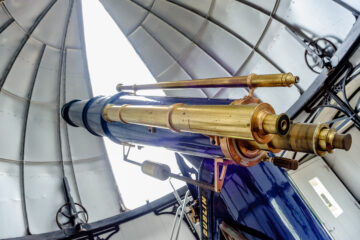NGC stands for the New General Catalogue of Nebulae and Clusters of Stars, which is an astronomical catalogue of deep sky objects and was compiled in 1888 by the 4th director of the Armagh Observatory John Dreyer. To this day the NGC catalogue is still used by Astronomers all over the world and remains one of our many claims to fame! The catalogue contains 7840 objects including nebulae, galaxies, globular cluster, supernova remnants and planetary nebulae, all of which are given an NGC number. So, let us have a look at some of the most interesting NGC objects, in my opinion of course.
Let’s begin with the NGC 5194 better known as the Whirlpool Galaxy located 23 million light years away in the constellation of Canes Venatici. It was discovered in 1773 by Charles Messier when charting the night skies and you might recognize the name messier after the Messier catalogue which is another very famous list of astronomical objects still used to this day, with the whirlpool galaxy also being referred to as M51. In 1845 Irish astronomer William Parsons, working with Armagh Observatory’s 3rd Director Romney Robinson, while using the 72-inch reflecting telescope at Birr Castle Co Offlay was the first to discover the spiral nature of this “nebulae”. It was not until the 1920’s that astronomers understood that these “spiral nebulae” were actually distant galaxies. So, not only does NGC 5194 have a link to Ireland, but it was also the very first spiral galaxy to be identified.

Another fascinating object is NGC 7293 – more commonly known as the Helix nebula, which is a planetary nebula; a star dying that has swollen in size, puffed off its outer layers and shrunk back down to create a tiny white dwarf star. The name “planetary nebulae” was coined in the 18th century by William Hershel before the distinction between planets and nebula had been made, planetary nebula have in fact nothing to do with planets! This is also how our Sun will die but do not worry this won’t happen for another five billion years.
The Helix nebula is one of the brightest and closest nebulae to Earth at a mere 700 light years away and estimated to be 10,000 years old. Astronomers also believe that the Helix Nebula once had a system of planets, moons, comets, and other celestial objects orbiting around the star just as Earth and orbits around our Sun. On a clear dark night, it is even possible to spot the Helix nebula with a pair of binoculars found in the constellation of Aquarius. The Helix nebula is a beautiful example of a remnant of a dying star.

Up next is our neighbouring galaxy NGC 244 better known as the Andromeda galaxy and at only 2.5 million light years away is it is the most distant object that can be seen with the naked eye with a magnitude of 3.4. NGC 244 is found the constellation of Andromeda, hence the name and can be seen in the Autumn months. It is the largest galaxy in our local group of galaxies and is estimated to have over one trillion stars, double the amount in our Milky Way galaxy. The Andromeda has helped astronomer in understanding the origins of evolution of spiral galaxies due to its close proximity to us. Eventually the Andromeda Galaxy with collide and merge with our Milky Way galaxy in around 4.5 billion years to form one giant single elliptical galaxy, so we are safe for another few billion years! However, what is most fascinating is that during this galaxy collision, it is thought that no induvial stars will collide with each other, as the space between the star is so vast compared to the actual sizes of the stars themselves.
How can we talk about interesting NGC objects without including NGC 1976 or the Orion nebula? It can be found to the south of Orion’s belt and is visible to the naked eye although it will only appear as a small fuzzy smudge. The Orion Nebula is the closest star forming region to Earth at a not so distant 1300 lightyears away. The nebula is a massive stellar nursery composed of gas and dust containing hundreds of very hot young stars and has given astronomers a greater understanding of star and planetary formation. At the centre of this nebula are four bright stars called the Trapezium because they are arranged in a trapezoid pattern, radiation from these stars light up much of the nebula. The Hubble Space Telescope has taken the sharpest image ever of the Orion nebula allowing us to peep inside the cavern of dust and cloud, revealing over 3,000 young stars of various sizes which are shaping the nebula.

This time we are moving south to the not so well-known southern constellation of Pavo the peacock where we will find NGC 6872 also known as the Condor Galaxy, which is a massive barred spiral galaxy located 212 million light years from Earth and is believed to be approximately five billion years old. NGC 6872 has the honour of being one of the largest known galaxies and therefore I think it deserves a worthy mention. The galaxy spans an impressive 522,000 light years across making it 5 times larger than our Milky Way and containing anywhere from 500 billion to 2 trillion stars! Also know for its unusual shape the Condor Galaxy has two extended arms making it one of the most elongated barred galaxies known likely a result of its collision with the much smaller galaxy IC 4970. NGC 6872 is in fact visible with a small telescope although only in the southern hemisphere, and it very unlikely that many of us in the Northern hemisphere will be travelling south anytime soon!







0 Comments